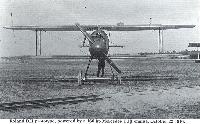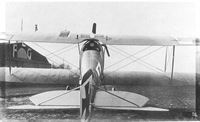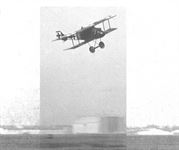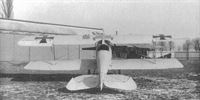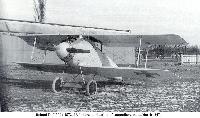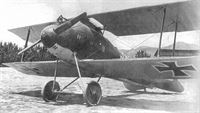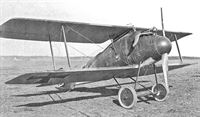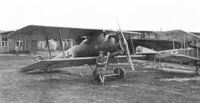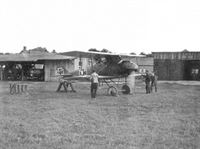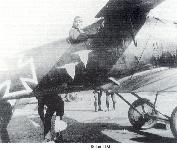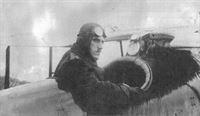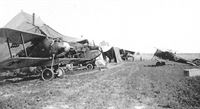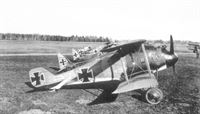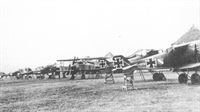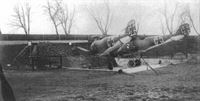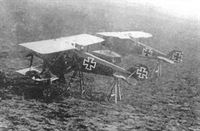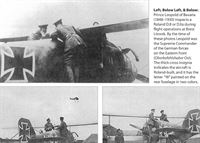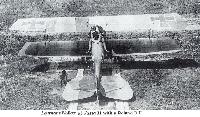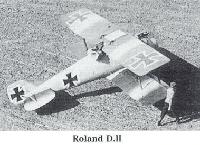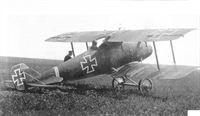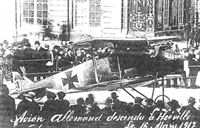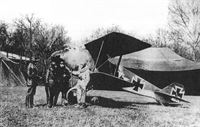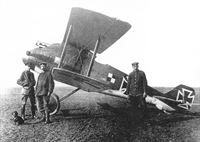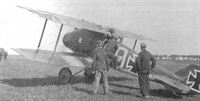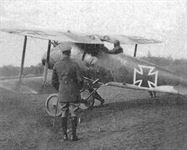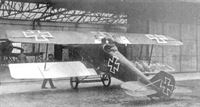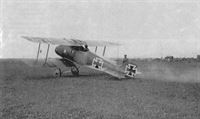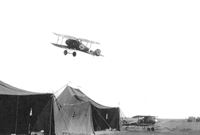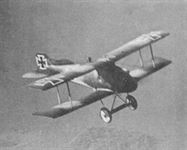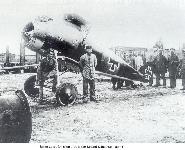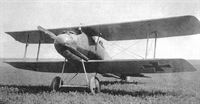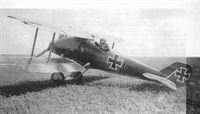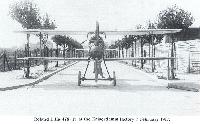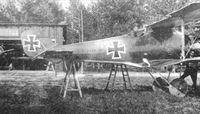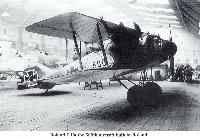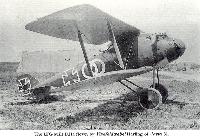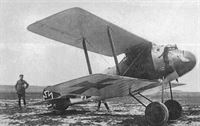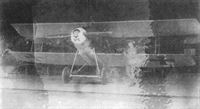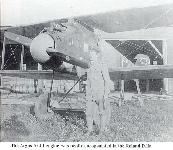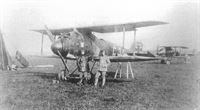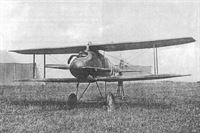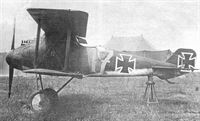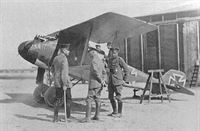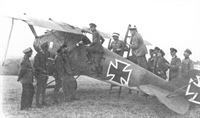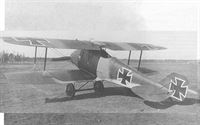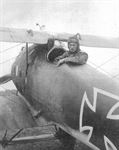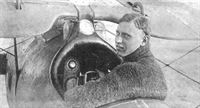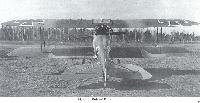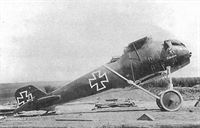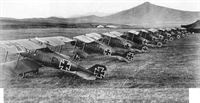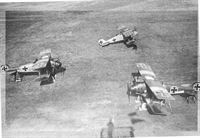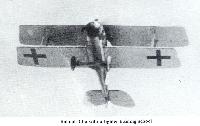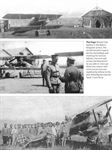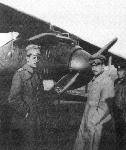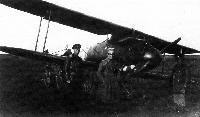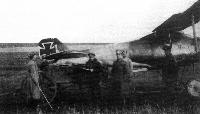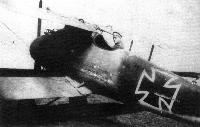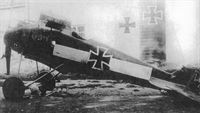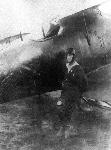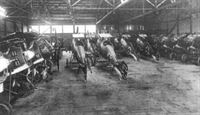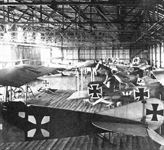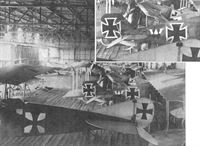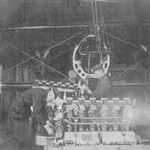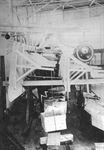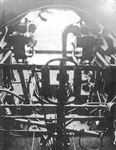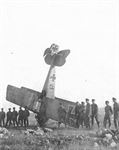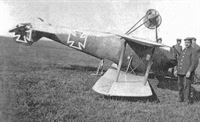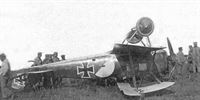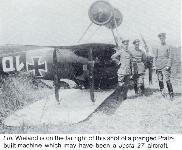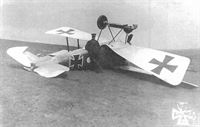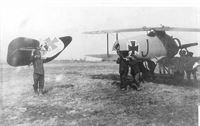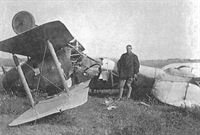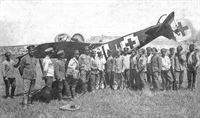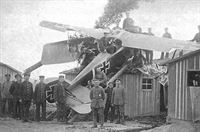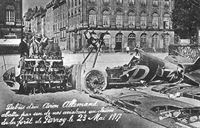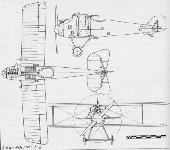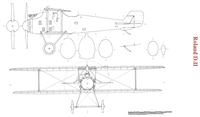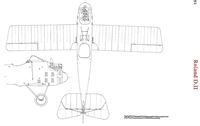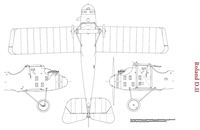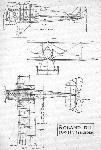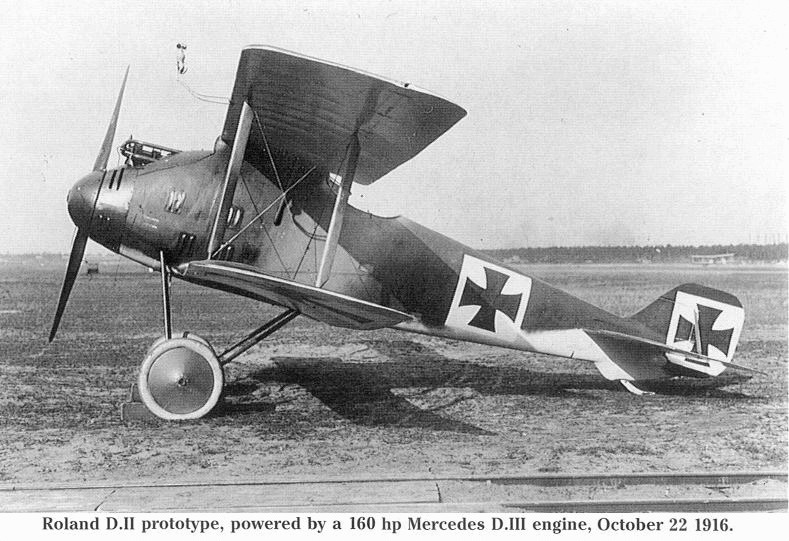
Описание
Страна: Германия
Год: 1916
Истребитель
Варианты
- LFG Roland - D.I - 1916 - Германия
- LFG Roland - D.II - 1916 - Германия
- LFG Roland - D.III - 1917 - Германия
- В.Кондратьев Самолеты первой мировой войны
- А.Александров, Г.Петров Крылатые пленники России
- O.Thetford, P.Gray German Aircraft of the First World War (Putnam)
- W.Green, G.Swanborough The Complete Book of Fighters
- J.Herris Roland Aircraft of WWI (A Centennial Perspective on Great War Airplanes 9)
- J.Herris Pfalz Aircraft of WWI (A Centennial Perspective on Great War Airplanes 5)
- M.Dusing German Aviation Industry in WWI. Volume 1 (A Centennial Perspective on Great War Airplanes 84)
- Журнал Flight
-
J.Herris - Roland Aircraft of WWI /Centennial Perspective/ (9)
Roland D.II prototype
-
J.Herris - Roland Aircraft of WWI /Centennial Perspective/ (9)
Roland D.II of Jasta 27
-
J.Herris - Roland Aircraft of WWI /Centennial Perspective/ (9)
Roland D.ll, unit unknown
-
J.Herris - Roland Aircraft of WWI /Centennial Perspective/ (9)
Roland D.II of Jasta 32.
-
J.Herris - Roland Aircraft of WWI /Centennial Perspective/ (9)
Roland D.II on the Eastern Front.
-
J.Herris - Pfalz Aircraft of WWI /Centennial Perspective/ (5)
Pfalz D.II, later Roland D.II(Pfal), wears the usual Roland D.II factory finish of green and brown upper surfaces and light blue undersurfaces. The white fuselage band is an individual marking.
-
J.Herris - Pfalz Aircraft of WWI /Centennial Perspective/ (5)
Pfalz D.II, later Roland D.II(Pfal), wears the usual Roland D.II factory finish of green and brown upper surfaces and light blue undersurfaces. The white zigzag on the fuselage is an individual marking.
-
J.Herris - Development of German Warplanes in WWI /Centennial Perspective/ (1)
Pfalz D.II, later Roland D.II(Pfal), wears the usual Roland D.II factory finish of green and brown upper surfaces and light blue undersurfaces. The black band with white '10' is an individual marking.
This Roland D.II(Pfal) flew with Kest 4 on the Eastern Front. Using the same engine and weapons as the Albatros fighters, the Roland fighters were strong and fast but had mediocre maneuverability and handling characteristics, and the pilot's field of view was poor. As a result the Rolands served in relatively small numbers while the Albatros was built in great quantity. -
J.Herris - Roland Aircraft of WWI /Centennial Perspective/ (9)
Roland D.II Edith serving with Jasta 15
-
В.Обухович, А.Никифоров - Самолеты Первой Мировой войны
LFG Роланд D II
-
J.Herris - Roland Aircraft of WWI /Centennial Perspective/ (9)
Roland D.II(Pfal), unit unknown.
-
В.Кондратьев - Самолеты первой мировой войны
Роланд D.II, пилот - вицефельдфебель Г.Физлер, весна 1918г.
-
J.Herris - Roland Aircraft of WWI /Centennial Perspective/ (9)
Roland D.IIa of Jasta 25 in Macedonia. Most likely this was the aircraft flown by 19-victory ace Vzfw. Gerhard Fieseler.
-
J.Herris - Roland Aircraft of WWI /Centennial Perspective/ (9)
Roland D.IIa of Jasta 27 flown by Unteroffizier Stein.
-
J.Herris - Roland Aircraft of WWI /Centennial Perspective/ (9)
Roland D.II with the coat-of-arms of the city of Halle an der Saale
-
J.Herris - Roland Aircraft of WWI /Centennial Perspective/ (9)
Roland D.IIa of Jasta 31 flown by Vzfw. Harling.
-
J.Herris - Roland Aircraft of WWI /Centennial Perspective/ (9)
Roland D.IIa of Jasta 32 flown by Vzfw. Paul Raetsch.
-
J.Herris - Roland Aircraft of WWI /Centennial Perspective/ (9)
Roland D.IIa serving on the Eastern Front, unit unknown
-
J.Herris - Roland Aircraft of WWI /Centennial Perspective/ (9)
Roland D.IIa(Pfal) serving on the Eastern Front, unit unknown.
-
J.Herris - Roland Aircraft of WWI /Centennial Perspective/ (9)
Roland D.IIa of the Jastaschule at Valenciennes.
-
J.Herris - Roland Aircraft of WWI /Centennial Perspective/ (9)
Roland D.IIa of the Bulgarian Air Service.
-
В.Кондратьев - Самолеты первой мировой войны
"Роланд" D.IIa, пилот Ханс Пиппарт, Галиция, лето 1917г.
-
O.Thetford, P.Gray - German Aircraft of the First World War /Putnam/
L.F.G. Roland D II prototype, powered by a 160 hp Mercedes D.III engine, October 22 1916.
Improved forward and downward view from the cockpit was offered by the Roland D II. -
Сайт - Pilots-and-planes /WWW/
The prototype Roland D.II on Oct. 22, 1916 in front of the LFG flight test hangar. An anemometer airspeed indicator is mounted on the upper left wing.
-
J.Herris - Roland Aircraft of WWI /Centennial Perspective/ (9)
Roland D.II prototype, powered by a 160 hp Mercedes D.III engine, October 22, 1916, in front of the LFG flight test hangar. An anemometer airspeed indicator is mounted on the upper left wing.
-
J.Herris - Roland Aircraft of WWI /Centennial Perspective/ (9)
Roland D.II prototype in October 1916 flying over the Adlershof aerodrome in October 1916.
-
J.Herris - Roland Aircraft of WWI /Centennial Perspective/ (9)
Fresh from the Pfalz factory, and immaculate D.II (Pfal) 2872/16 poses for the camera before the application of camouflage in March 1917. The gravity fuel tank in the left wing was used on late-production aircraft.
-
Сайт - Pilots-and-planes /WWW/
Roland D.II(Pfal) 2872/16, before the application of camouflage paint, March 1917.
-
J.Herris - Roland Aircraft of WWI /Centennial Perspective/ (9)
The port radiator section of this Roland has been removed for maintenance, clearly showing its normal location.
-
J.Herris - Roland Aircraft of WWI /Centennial Perspective/ (9)
The Roland D.IIa had a slightly lengthened nose to accommodate its 180 hp Argus As.III engine. Just below the aileron control rod is the Roland logo.
-
J.Herris - Roland Aircraft of WWI /Centennial Perspective/ (9)
Roland D.II of Kest 4b shares an airfield with a Fokker D.II in the background.
Другие самолёты на фотографии: Fokker D.II / M.17 - Германия - 1916
-
J.Herris - Roland Aircraft of WWI /Centennial Perspective/ (9)
This Roland D.II(Pfal) has had some of its cowling panels removed for engine maintenance. An Albatros C.III is in the background.
Другие самолёты на фотографии: Albatros C.III - Германия - 1916
-
J.Herris - Roland Aircraft of WWI /Centennial Perspective/ (9)
A Roland-built Roland D.II runs up its engine in preparation for take off.
-
В.Кондратьев - Самолеты первой мировой войны
"Роланд" D.II, построенный на заводе "Пфальц".
-
J.Herris - Roland Aircraft of WWI /Centennial Perspective/ (9)
This Roland D.II fighter carried two broad white fuselage bands as identify markings.
-
Сайт - Pilots-and-planes /WWW/
Roland D.II
-
Сайт - Pilots-and-planes /WWW/
Roland D.II with Lt. Anslinger.
-
J.Herris - Roland Aircraft of WWI /Centennial Perspective/ (9)
Vzfw. Richard Scholz in his Roland D.II at Flieger-Abteilung 21 on the Eastern Front. The instrument mounted above the altimeter appears to be a clock.
-
Сайт - Pilots-and-planes /WWW/
Jasta 27 lineup; a single Roland D.II is at left in a lineup consisting mostly of Albatros D.III and D.V fighters.
Другие самолёты на фотографии: Albatros D.III - Германия - 1916Albatros D.V/D.Va - Германия - 1917
-
J.Herris - Roland Aircraft of WWI /Centennial Perspective/ (9)
Typical Eastern Front mixed unit with Roland D.IIs and an Albatros C.III.
-
J.Herris - Roland Aircraft of WWI /Centennial Perspective/ (9)
This unit lineup features a Roland-built D.II in the foreground followed by Halberstadt and Fokker biplanes.
Другие самолёты на фотографии: Halberstadt D.II/D.III - Германия - 1916
-
J.Herris - Roland Aircraft of WWI /Centennial Perspective/ (9)
Roland D.II fighters in the field; two of them carry additional identity markings on their fuselages.
-
J.Herris - Roland Aircraft of WWI /Centennial Perspective/ (9)
Roland D.II Edith and Albatros D.III fighters of Jasta 15.
Другие самолёты на фотографии: Albatros D.III - Германия - 1916
-
J.Herris - Roland Aircraft of WWI /Centennial Perspective/ (9)
Roland D.II fighters in wooden hangars with Flieger-Abteilung 15 on the Eastern Front. The men appear to be watching a flying display of some sort.
-
J.Herris, J.Leckscheid - Fokker Aircraft of WWI. Vol.3: Early Biplane Fighters /Centennial Perspective/ (53)
Fokker D.II at right with a Roland D.II at left. This photo is taken at a unit on the Eastern Front, possibly Galicia, Poland. Fighter aircraft were supplied in twos and threes to the Fliegerabteilungen there. The Roland D.II started replacing the lower-powered Fokkers in the early Spring of 1917.
Другие самолёты на фотографии: Fokker D.II / M.17 - Германия - 1916
-
J.Herris - Roland Aircraft of WWI /Centennial Perspective/ (9)
D.II fighters waiting for their next mission.
-
J.Herris - Roland Aircraft of WWI /Centennial Perspective/ (9)
These Roland-built D.II fighters have been disassembled for transportation. They are in the gun pits having their guns sighted and tested.
-
J.Herris - Roland Aircraft of WWI /Centennial Perspective/ (9)
Roland D.IIs on the Eastern Front; the aircraft in front was built by Pfalz, and that in the rear was built by Roland. The distinguishing feature is the thickness of the iron cross insignia; the Pfalz-built aircraft has insignia of normal proportions, while Roland painted thicker crosses on the aircraft it produced.
-
J.Herris - Roland Aircraft of WWI /Centennial Perspective/ (9)
Prince Leopold of Bavaria (1848-1930) inspects a Roland D.II or D.IIa during flight operations at Brest Litovsk. By the time of these photos Leopold was the Supreme Commander of the German forces on the Eastern front (Oberbefehlshaber Ost). The thick cross insignia indicates the aircraft is Roland-built, and it has the letter "W" painted on the rear fuselage in two colors.
-
Сайт - Pilots-and-planes /WWW/
Leutnant Wolker of Jasta 31 with a Roland D.II
-
Сайт - Pilots-and-planes /WWW/
Roland D.II
-
J.Herris - Roland Aircraft of WWI /Centennial Perspective/ (9)
Pfalz-built Roland D.II on the Eastern Front. From building Roland fighters Pfalz learned the Wickelrumpf wrapped-plywood fuselage construction that was used in all subsequent original Pfalz fighter designs.The Roland D.II replaced the ear radiators of the D.I with airfoil radiators for lower drag, and mounted the upper wing on a pylon for better visibility.
-
J.Herris - Roland Aircraft of WWI /Centennial Perspective/ (9)
French postcard of von Hausen's downed Roland D.II captured May 16, 1917.
-
J.Herris - Roland Aircraft of WWI /Centennial Perspective/ (9)
This Roland D.II, possibly of Jasta 32, carries a personal marking of two white birds on each side of the fuselage.
-
J.Herris - Roland Aircraft of WWI /Centennial Perspective/ (9)
This Roland D.II or D.IIa carries a checkerboard personal marking.
-
J.Herris - Roland Aircraft of WWI /Centennial Perspective/ (9)
Roland D.II or D.IIa number 19 at Jastaschule I at Valenciennes.
-
J.Herris - Roland Aircraft of WWI /Centennial Perspective/ (9)
Roland D.II or D.IIa ready for take-off.
-
J.Herris - Roland Aircraft of WWI /Centennial Perspective/ (9)
This well-used Roland D.II(Pfal) appears to be at a fighter school.The numeral "8" appears below the cockpit and the lower left wing has been recovered in new fabric after a repair.
-
J.Herris - Roland Aircraft of WWI /Centennial Perspective/ (9)
A Roland-built Roland D.II starts is take-off run.
-
Сайт - Pilots-and-planes /WWW/
Roland D.II(Pfal) on the Eastern Front
-
J.Herris - Roland Aircraft of WWI /Centennial Perspective/ (9)
Future ace Lt. Hans Pippart flying his Roland D.II(Pfal) while with Flieger-Abteilung 220 on the Eastern Front.
-
J.Herris - Roland Aircraft of WWI /Centennial Perspective/ (9)
Roland D.II in flight. If the Roland D.II was not the superior fighter the Albatros was, it was a welcome replacement for the primitive Eindecker fighters on the Eastern Front. The Roland was faster, better armed, and stronger than the Fokker and Pfalz Eindeckers and was significantly superior to them. It was also stronger than the V-strutter Albatros fighters and was not subject to the lower-wing structural failures that plagued those fighters.
-
J.Herris - Roland Aircraft of WWI /Centennial Perspective/ (9)
Production Roland D.II in flight.
-
Сайт - Pilots-and-planes /WWW/
Taken apart for transport is the Roland D.IIa(Pfal) 359/17.
-
J.Herris - Roland Aircraft of WWI /Centennial Perspective/ (9)
Roland D.IIa(Pfal) 374/17 on the Koledziany airfield.
The Roland D.II used the 160 hp Mercedes D.III; the Roland D.IIa used the 180 hp Argus As.III. -
J.Herris - Roland Aircraft of WWI /Centennial Perspective/ (9)
Roland D.IIa(Pfal) 374/17 at Koledziany airfield on the Eastern Front, possibly as part of the equipment of the Jagdkommando of Fl.Abt.(A)220. In addition to the standard insignia, the lack of a tail skid fairing identifies this aircraft as Pfalz-built. The Roland D.IIa was used extensively on the Eastern Front, where the air combat environment was more permissive than on the Western Front and the D.IIa could make use of its strengths, good speed, strong armament, and a robust structure, against two-seaters while its weaknesses, poor maneuverability and handling and modest climb over 3,000 m due to its Argus engine, were not as important.
-
O.Thetford, P.Gray - German Aircraft of the First World War /Putnam/
Roland D IIa 478/17 at the Kaiserdamm factory 7 February 1917.
-
Сайт - Pilots-and-planes /WWW/
Roland D IIa 478/17 at the Kaiserdamm factory 7 February 1917.
-
J.Herris - Roland Aircraft of WWI /Centennial Perspective/ (9)
Roland D.IIa(Pfalz) 713/16 of Flieger-Abteilung 21, Eastern Front. Some Pfalz-built aircraft had a faired tail skid.
-
Сайт - Pilots-and-planes /WWW/
This Roland D.IIa, completed the morning of 7 Feb. 1917, was the 500th Roland airplane built during the war.
-
Сайт - Pilots-and-planes /WWW/
The LFG-built D.IIa flown by Vizefeldwebel Harling of Jasta 31.
-
J.Herris - Roland Aircraft of WWI /Centennial Perspective/ (9)
Roland D.IIa serving at the front.
-
Сайт - Pilots-and-planes /WWW/
19-victory ace Vzfw. Gerhard Fieseler in the cockpit of Lt. Ahelfeld's Roland D.IIa of Jasta 25 in Macedonia. Jasta 25 Roland fighters were normally identified by the initial of the pilot's last name; here, 'A' for Ahelfeld. Fieseler's aircraft would most likely have had an 'F' for identification. After the war Fieseler started his own aircraft company; his most famous product was the Fi-156 Fieseler Storch (Stork) known for its exceptional low speed flying qualities and ability to make very short landings and take-offs.
-
J.Herris - Roland Aircraft of WWI /Centennial Perspective/ (9)
Roland D.IIa of Vzfw. Paul Raetsch of Jasta 32 wears a macabre skull and bones on its spinner.
-
Сайт - Pilots-and-planes /WWW/
The Argus As.III engine was neatly encapsulated in the Roland D.IIa.
-
J.Herris - Roland Aircraft of WWI /Centennial Perspective/ (9)
Roland-built D.IIa on the Eastern Front with a Pfalz-built D.II in the right background.
-
J.Herris - Roland Aircraft of WWI /Centennial Perspective/ (9)
Roland D.IIa number 17 at Jastaschule I at Valenciennes. The number was painted yellow.
-
J.Herris - Roland Aircraft of WWI /Centennial Perspective/ (9)
Roland D.IIa number 17 at Jastaschule I at Valenciennes. The number was painted yellow.
-
M.Dusing - German Aviation Industry in WWI. Volume 1 /Centennial Perspective/ (84)
Roland D.IIa "Haifisch" (1917)
-
J.Herris - Roland Aircraft of WWI /Centennial Perspective/ (9)
This Roland D.IIa interests the visiting officers.
-
J.Herris - Roland Aircraft of WWI /Centennial Perspective/ (9)
Roland D.IIa "S" of Jasta 25 in Macedonia is inspected by a group of curious officers.
-
Журнал - Flight за 1918 г.
Roland D.IIa, at Adlershof during Winter 1916-1917
-
J.Herris - Roland Aircraft of WWI /Centennial Perspective/ (9)
"Роланд" D.II, построенный на заводе LFG.
Roland D.IIa built by Roland wears the standard Roland factory finish devoid of serial numbers. However, data is stenciled below the cockpit. Above the rigging datum line is Leergewicht 600 kg (Empty weight 600 kg); below the datum line is Zul. Nutzlast bei vollem Tank 167 kg (Permissible useful load with full tank 167 kg). -
J.Herris - Roland Aircraft of WWI /Centennial Perspective/ (9)
At 44 years old, Lt. Friedrich N. Guttler was one of the oldest fighter pilots and was, of course, known as 'Papa' to the other pilots of his unit, Jasta Ober Ost on the Eastern Front. Here he is in the cockpit of his Roland-built D.IIa.
-
J.Herris - Roland Aircraft of WWI /Centennial Perspective/ (9)
19-victory ace Vzfw. Gerhard Fieseler in the cockpit of his Roland D.IIa of Jasta 25 in Macedonia. A small windscreen is fitted on each side of the central pylon; the one at right has a small hole for aiming the guns. The bars in front of the windscreens mounted the rear gunsights. The large instrument is the altimeter.
-
Сайт - Pilots-and-planes /WWW/
LFG-built Roland D.IIa.
-
Сайт - Pilots-and-planes /WWW/
Roland D.IIa, at Adlershof during Winter 1916-1917
-
J.Herris - Roland Aircraft of WWI /Centennial Perspective/ (9)
Roland D.IIa "K"of Jasta 25 in Macedonia is ready for take-off.
-
J.Herris - Roland Aircraft of WWI /Centennial Perspective/ (9)
The crest on the side of this Roland D.IIa is the Municipal Wappen (coat-of-arms) of the city of Halle an der Saale in southern Germany, in what is now Saxony-Anhalt. The stars and crescent moon were red on a white shield.
-
Журнал - Flight за 1918 г.
The curious body of the German Roland single-seater chaser biplane. The centre sections of the wings are left in place, and show where the planes are attached. The top plane, it will be noticed, is attached to the top of the fuselage. Note the balanced rudder and elevators.
-
J.Herris - Roland Aircraft of WWI /Centennial Perspective/ (9)
Roland D.IIa(Pfal) Silberfisch dismantled for transport.
-
Z.Czirok - German Aircraft in Hungarian Service /Centennial Perspective/ (92)
Bulgarian Roland D.II captured at Krivolak rail station on 21st September 1918. (Boris Ciglic)
-
J.Herris - Roland Aircraft of WWI /Centennial Perspective/ (9)
Jasta 25's LFG Roland D II single seat fighters lined up on their Catnatlarzi base in Macedonia during 1917. First flown in October 1916, the twin 7.92mm Spandau armed D II was built in far greater quantities than either of the company's D I or D III designs. Like the D I, the D II used a 160hp Mercedes D III that gave a top level speed of 105mph at sea level. Entering service in early 1917, a total of around 300 D IIs are believed to have been built, both by LFG and Pfalz. The machine was not unconditionally loved by its pilots, who found it particularly sensitive, especially in the yawing plane. Incidentally, this image, showing as it does no less than ten D IIs, goes some way to refute the often made claim that no unit seems to have been exclusively D II-equipped. The individual letters were the first initials of the pilots' last names. All are Roland-built except the last in line appears to be built by Pfalz.
-
J.Herris - Roland Aircraft of WWI /Centennial Perspective/ (9)
Roland D.IIa fighters of Jasta 25 lined up in Macedonia.
-
J.Herris, J.Leckscheid - Fokker Aircraft of WWI. Vol.3: Early Biplane Fighters /Centennial Perspective/ (53)
The equipment of Kest 4b was progressively upgraded, and by 1 June 1917, the first Roland D.II arrived. Six of these aircraft replaced the oldest fighters and took center stage here, and when this photo was taken around July or August, only three Fokker D.III remained with the unit. Seen from right to left are: Fokker D.III 1583/16 Max, 1593/16, and 1638/16. The "Iron Cross" wheel cover marking was not carried over to the Roland and Albatros fighters. Three Albatros D.III complete the distant end of the lineup, which shows the opposite direction of the airfield at Freiburg. By 1 September, the last of the Fokker single-seaters had been given up by the unit.
Другие самолёты на фотографии: Albatros D.III - Германия - 1916Fokker D.III / M.19 - Германия - 1916
-
J.Herris - Roland Aircraft of WWI /Centennial Perspective/ (9)
Roland D.IIa in the foreground and two Mercedes-engined Roland D.II fighters in th background. The two nearest fighters were built by Roland; the fighter in the background has no camouflage on its fuselage and may be Pfalz built.
-
Сайт - Pilots-and-planes /WWW/
Dramatic view of a Roland D.IIa in Bulgarian service in 1918 as indicated by the late-style insignia.
-
D.Mechin - Oriental Adventures of the French Air force 1914-1918 /Aeronaut/
Roland D.II fighter of the Bulgarian air service.
-
J.Herris - Roland Aircraft of WWI /Centennial Perspective/ (9)
Roland D.IIa fighters in the field in Bulgarian service. The aircraft served in typical factory camouflage and markings for German fighters. Fast and well-armed, the Roland D.II/IIa was able to intercept Allied two-seaters with some success but was significantly inferior to the best Allied fighters like the Spad 13 and SE.5a.
-
A.Durkota, T.Darcey, V.Kulikov - The Imperial Russian Air Service /Flying Machines/
Sveshnikov's victory of September 22, 1917, for which he was awarded the Order of Saint George Fourth Class. The machine is a Roland D.IIa powered by a 180hp Argus engine. The aircraft landed in no-man's-land near the village of Poznanka Gnila, where it was salvaged by Russian troops.
-
A.Durkota, T.Darcey, V.Kulikov - The Imperial Russian Air Service /Flying Machines/
Sveshnikov seated in his trophy. A long scar in the plywood fuselage from a bullet can be seen through the Iron Cross Insignia.
-
J.Herris - Roland Aircraft of WWI /Centennial Perspective/ (9)
Pfalz-built Roland D.IIa (w/n 539) captured by the Russians after being shot down on Sept. 9, 1917 by Poruchik (Lieutenant) Alexander Sveshnikov of the Russian 7th Corps air detachment, 2nd fighting air group. The pilot escaped back to German lines. The broad white marking along the fuselage side is distinctive.
-
J.Herris - Roland Aircraft of WWI /Centennial Perspective/ (9)
Roland D.IIa fighters in storage waiting distribution to front-line units.
-
J.Herris - Aviatik Aircraft of WWI /Centennial Perspective/ (10)
An Aviatik C.II in the center background in a hangar at Brest-Litovsk on the Eastern Front.
Другие самолёты на фотографии: Albatros C.III - Германия - 1916Aviatik C.II - Германия - 1916
-
J.Herris - Roland Aircraft of WWI /Centennial Perspective/ (9)
Scenes of Roland D.II fighters at Brest-Litovsk on the Eastern Front. The German Army captured the city in 1915 and at the time of these photos it was a center for aircraft distribution and aviation training behind the front. At right is a hangar with Roland D.II / D.IIa fighters and Albatros C.III reconnaissance aircraft. Inset clearly shows "W" in two colors on a D.IIa.The air combat environment in the east was much more permissive than the Western Front, which had a much higher density of first-rate combat aircraft. This enabled the Germans to find useful service for mediocre aircraft like the Roland D.II and D.IIa.
Другие самолёты на фотографии: Albatros C.III - Германия - 1916Aviatik C.II - Германия - 1916
-
J.Herris - Roland Aircraft of WWI /Centennial Perspective/ (9)
The Mercedes D.III engine removed from a D.II reveals details of the Roland's structure.
-
J.Herris - Roland Aircraft of WWI /Centennial Perspective/ (9)
Roland D.II in a structural test rig at the factory.
-
J.Herris - Roland Aircraft of WWI /Centennial Perspective/ (9)
View from the cockpit of a D.II with engine removed shows details of the structure and guns.
-
J.Herris - Roland Aircraft of WWI /Centennial Perspective/ (9)
There was at least one in every unit; Pinkert of Jasta 25 in Macedonia does a head-stand in his Roland D.IIa.
-
J.Herris - Roland Aircraft of WWI /Centennial Perspective/ (9)
Roland D.II being recovered after a pilot's 'head-stand'.
-
J.Herris - Roland Aircraft of WWI /Centennial Perspective/ (9)
The pilots field of view forward and downward from the Roland D.II was little better than that from the C.II with similar results; the landing flair could not be judged well and landing accidents were common.
-
J.Herris - Roland Aircraft of WWI /Centennial Perspective/ (9)
Over-turned D.II with unusual half-circle marking.
-
Сайт - Pilots-and-planes /WWW/
Ltn. Wieland is on the far right of this shot of a pranged Pfalz-built machine which may have been a Jasta 27 aircraft.
-
J.Herris - Roland Aircraft of WWI /Centennial Perspective/ (9)
Roland-built D.IIa after a landing accident shows its underside details. Although embarrassed, pilot Vzfw. Paul Raetsch of Jasta 32 fortunately appears unhurt.
-
J.Herris - Roland Aircraft of WWI /Centennial Perspective/ (9)
Jasta 27 mishap; Unteroffizier Stein stalled and crashed from 30 m during takeoff. Despite breaking the tail off his sturdy Roland D.IIa, Stein was not injured in the crash.
-
J.Herris - Roland Aircraft of WWI /Centennial Perspective/ (9)
Crashed Roland D.IIa of Jasta 25 in Macedonia; the abashed pilot is photographed with the evidence.
-
J.Herris - Roland Aircraft of WWI /Centennial Perspective/ (9)
A Bulgarian Roland D.IIa after a landing accident is used as a background for a group photo.
-
J.Herris - Roland Aircraft of WWI /Centennial Perspective/ (9)
This Roland D.II(Pfal) with "J" marking behind the insignia is in an embarrassing situation. One wonders how the pilot could find this building so precisely when it is surrounded by so much open terrain.
-
J.Herris - Roland Aircraft of WWI /Centennial Perspective/ (9)
French postcard of the downed Roland D.II of Uffz. Tolischuss, Kest 3, made POW May 23, 1917.
-
Журнал - Flight за 1918 г.
The upper plane of the Roland D. II.
-
Журнал - Flight за 1918 г.
One of the main plane ribs of the Roland D. II.
-
Журнал - Flight за 1918 г.
Diagram of "bump" supporting top plane and radiator on the Roland D. II.
-
Журнал - Flight за 1918 г.
The quick-release bolt for attaching main planes on the Roland D. II.
-
M.Dusing - German & Austro-Hungarian Aero Engines of WWI. Vol.2 /Centennial Perspective/ (65)
160hp Mercedes in Roland D.II.
-
Журнал - Flight за 1917 г.
The Roland chaser D. II.
-
R.Kosin - The German Fighter since 1915 /Putnam/
LFG Roland D IIa
-
Журнал - Flight за 1918 г.
THE ROLAND SINGLE-SEATER CHASER, D. II. - Plan, side and front elevations to scale.
-
В.Кондратьев - Самолеты первой мировой войны
Roland D.II
В.Кондратьев Самолеты первой мировой войны
"РОЛАНД " D.II/D.III / ROLAND D.II/D.III
После восстановления предприятия на нем запустили в серию улучшенную модификацию истребителя - "Роланд" D.II. Верхнее крыло у него было приподнято и установлено на невысоком пилоне, чтобы улучшить обзор вниз. Вооружение усилено на один пулемет, а два бортовых радиатора заменили одним, размещенным на верхнем крыле.
D.II выпускался с октября 1916 года, а с декабря начал поступать на фронт. В ноябре появилась очередная модификация D.IIa, оснащенная двигателем "Аргус" As.III мощностью 180 л.с. Вскоре D.IIa сменил D.II на линии сборки.
Всего на фирмах LFG и "Пфальц" построено 70 экземпляров D.II и 300 D.IIa. Выпуск прекращен в феврале 1917 г.
<...>
Самолеты "Роланд" отличались высокой прочностью конструкции и хорошими скоростными данными, но по остальным показателям они уступали "Альбатросу". Кроме того, двигатель "Аргус" оказался недостаточно надежным и постоянно недодавал мощности. Из-за этого "роланды" не получили широкого распространения на западе, но часть машин использовалась на восточном фронте, где некоторые из них были сбиты в воздушных боях русскими летчиками. Две трофейные машины применялись в российской авиации.
Шесть экземпляров D.II и столько же D.III были переданы Болгарии и воевали в составе болгарских ВВС на македонском фронте.
МОДИФИКАЦИИ
D.II; двигатель "Мерседес", 160 л.с. Построено 70 штук в октябре-ноябре 1916 г.
D.IIа; двигатель "Аргус", 180 л.с. Построено 370 экз. в ноябре 1916 - феврале 1917 гг.
ВООРУЖЕНИЕ:
2 синхр. LMG 08/15 "Шпандау".
ЛЕТНО-ТЕХНИЧЕСКИЕ ХАРАКТЕРИСТИКИ
Размах, м 8,94
Длина, м 6,85
Площадь крыла, кв.м 22,80
Сухой вес, кг 685
Взлетный вес, кг 915
Скорость максимальная, км/ч 180
Время подъема на высоту
2000 м, мин 6,0
5000 м, мин 23,0
Потолок, м 5000
Описание:
























